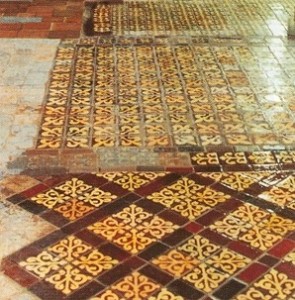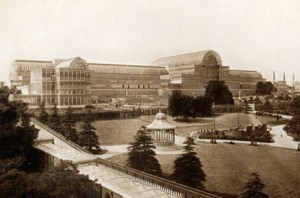Medieval Tiles (Shire Album) by Hans Van Lemmen (2004)
Inlaid tiles, or ‘encaustic’ tiles as they are also known, are fired clay tiles with a simple pattern such as an heraldic motif picked out in a clay inlay of a contrasting colour, usually in white on a red ground. The tiles are glazed and were originally fired in a wood burning kiln. They depend entirely upon the raw clays and glazes for their colours, and not pigments, paint or enamels. The tiles developed from about 1220 to about 1550, probably earliest on continental Europe, although the basic technique is likely of earlier Middle-eastern origin. They represent a significant development over earlier mosaic tile designs. They were probably inspired, at least in part, by the Italian marble mosaic floors, and attempts to achieve patterned floors with local materials.
of a contrasting colour, usually in white on a red ground. The tiles are glazed and were originally fired in a wood burning kiln. They depend entirely upon the raw clays and glazes for their colours, and not pigments, paint or enamels. The tiles developed from about 1220 to about 1550, probably earliest on continental Europe, although the basic technique is likely of earlier Middle-eastern origin. They represent a significant development over earlier mosaic tile designs. They were probably inspired, at least in part, by the Italian marble mosaic floors, and attempts to achieve patterned floors with local materials.
Encaustic or inlaid tiles enjoyed two periods of great popularity. The first lasted until Henry the Eighth’s reformation in the 16th century, and the second came when the tiles caught the attention of craftsmen during the Victorian Gothic Revival era, who after much trial and error mass-produced these tiles, made them available to the general public. During both periods tiles were made across Western Europe though the centre of tile production was in England. Companies in the United States also made encaustic tile during the Gothic Revival architecture style’s period.
The use of the word ‘encaustic’ to describe an inlaid tile of two or more colours is technically incorrect. The word ‘encaustic’ literally means “burning in”. The term originally described a process of painting with a beeswax-based paint that was then fixed with heat. It was also applied to a process of medieval enamelling. The term did not come into use when describing tile until the 19th century. Supposedly, Victorians thought that the two-colour tiles strongly resembled enamel work and so called them encaustic. Despite the error, the term has now been in common use for so long that it is an accepted name for inlaid tile work.
In both medieval times and in the 19th and 20th Century Gothic Revival, these tiles were most often made for and laid in churches. Even tiles that were laid in secular buildings appear to be copies of those found in religious settings. Encaustic tile floors exist all over Europe but are most prevalent in England where the greatest numbers of inlaid tiles were made..



